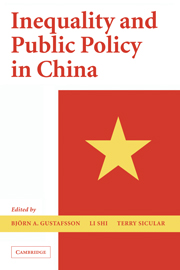Book contents
- Frontmatter
- Contents
- List of Tables and Figures
- Contributors
- Acknowledgments
- 1 Inequality and Public Policy in China: Issues and Trends
- 2 Income Inequality and Spatial Differences in China, 1988, 1995, and 2002
- 3 Growth and Distribution of Household Income in China between 1995 and 2002
- 4 Explaining Incomes and Inequality in China
- 5 The Distribution of Wealth in China
- 6 Growth, Inequality, and Poverty: A Comparative Study of China's Experience in the Periods before and after the Asian Crisis
- 7 What Has Economic Transition Meant for the Well-Being of the Elderly in China?
- 8 Inequity in Financing China's Health Care
- 9 China's Emerging Urban Wage Structure, 1995–2002
- 10 Unemployment, Earlier Retirement, and Changes in the Gender Income Gap in Urban China, 1995–2002
- 11 What Determines Living Arrangements of the Elderly in Urban China?
- 12 The Impact of Village-Specific Factors on Household Income in Rural China
- 13 The Redistributive Impact of Taxation in Rural China, 1995–2002: An Evaluation of Rural Taxation Reform at the Turn of the Century
- Appendix: The 1995 and 2002 Household Surveys: Sampling Methods and Data Description
- Index
- References
11 - What Determines Living Arrangements of the Elderly in Urban China?
Published online by Cambridge University Press: 25 July 2009
- Frontmatter
- Contents
- List of Tables and Figures
- Contributors
- Acknowledgments
- 1 Inequality and Public Policy in China: Issues and Trends
- 2 Income Inequality and Spatial Differences in China, 1988, 1995, and 2002
- 3 Growth and Distribution of Household Income in China between 1995 and 2002
- 4 Explaining Incomes and Inequality in China
- 5 The Distribution of Wealth in China
- 6 Growth, Inequality, and Poverty: A Comparative Study of China's Experience in the Periods before and after the Asian Crisis
- 7 What Has Economic Transition Meant for the Well-Being of the Elderly in China?
- 8 Inequity in Financing China's Health Care
- 9 China's Emerging Urban Wage Structure, 1995–2002
- 10 Unemployment, Earlier Retirement, and Changes in the Gender Income Gap in Urban China, 1995–2002
- 11 What Determines Living Arrangements of the Elderly in Urban China?
- 12 The Impact of Village-Specific Factors on Household Income in Rural China
- 13 The Redistributive Impact of Taxation in Rural China, 1995–2002: An Evaluation of Rural Taxation Reform at the Turn of the Century
- Appendix: The 1995 and 2002 Household Surveys: Sampling Methods and Data Description
- Index
- References
Summary
Introduction
The welfare of the elderly is an important issue in the study of income equality, as old age is often associated with low incomes and income insecurity, especially in the developing world where the social security system is not well established. When income distribution widens it is often the elderly who are among the increasingly disadvantaged. In China economic transition has adversely changed the economic well-being and social stratification of the elderly through health care and pension reforms (Raymo and Yu 2000; Saunders et al. 2003). Due to these reforms, many old workers lost their expected pensions and are currently under limited health and income protection. In addition, demographic changes brought about by the one-child policy have led China to join developed countries prematurely in becoming an aging society. Rapid aging has cast doubt on the ability of the newly established Pay-as-You-Go (PAYG) pension scheme (Cai and Meng 2003). If the current PAYG system fails, which has been argued by many studies (World Bank 1997; Whiteford 2003; Murton 2002), the elderly population will suffer significantly. Under these circumstances, a question naturally arises as to how China can adjust its policy to assist its aging population in this particularly difficult period. In this chapter we investigate one of the most effective ways through which the elderly's well-being may be improved – coresiding.
- Type
- Chapter
- Information
- Inequality and Public Policy in China , pp. 267 - 286Publisher: Cambridge University PressPrint publication year: 2008
References
- 2
- Cited by



